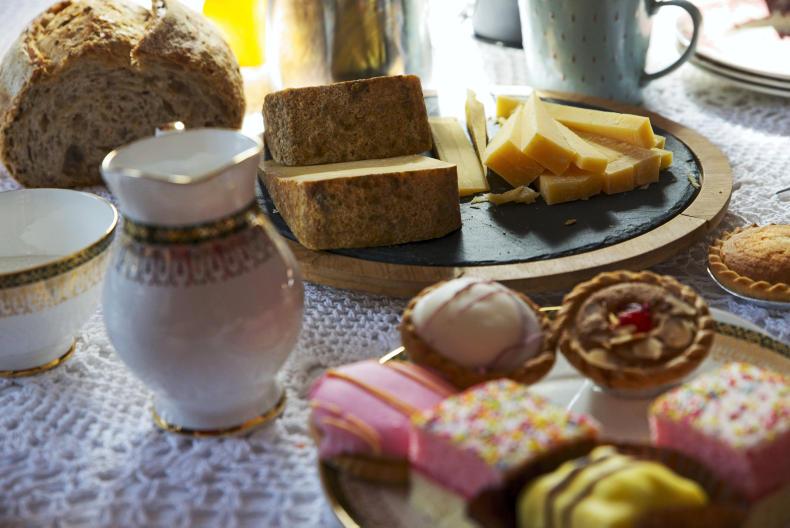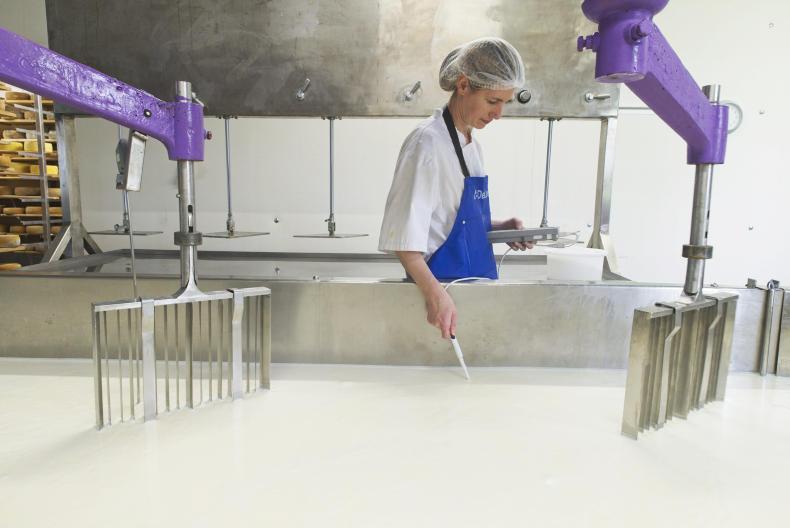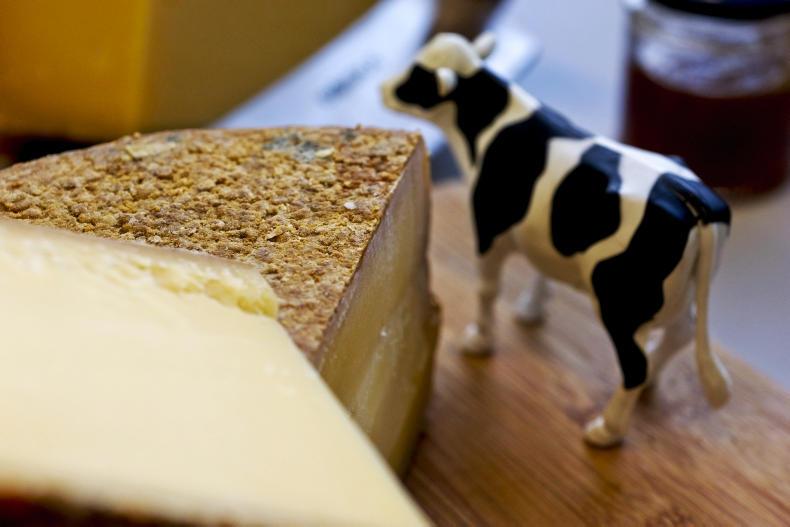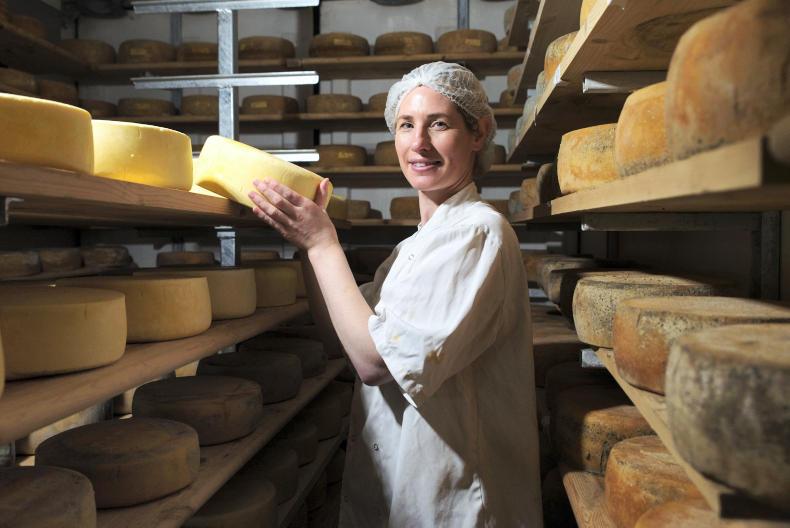Our food editor Ciara laughed when I mentioned I was going to meet a woman about cheese. Any previous food commentary of mine (and we are talking basic here) has been met with scepticism. I take this on board as I eat everything and generally do not complain about food. However, I wasn’t to be deterred. I convinced our food guru that Teresa Roche’s story was much more than just cheese.
Since her return from Australia, Teresa, as well as adding value to the family farm through Kylemore Farmhouse Cheese is also the Galway representative on the IFA farm family and social affairs committee and secretary of the Galway Friesian Breeders Association. And with that, I was reluctantly released to Loughrea in Co Galway.

Mature cheese. \ David Ruffles
Suffice to say I am therefore a tad surprised to be starting with the following. So far Irish Country Living has made a carbonara, a lasagne, omelettes and innumerable melted cheese toasties from the half wheel of cheese we were kindly gifted, on our departure, from the Roche farm.
However, there were many steps in Teresa’s journey before cheese.
Step back
She left home at 19, qualifying as a nurse from Kingston University and St George’s Hospital in west London in 2004. A post-grad followed and with experience across surgical, urology, breast oncology and emergency, she headed for Australia in 2006. Farming, however, was never far away. Working in emergency care in the Royal Melbourne Hospital, Teresa witnessed many farm accidents arriving by air ambulance.
I have no problem sharing information from what I have learned as I found it quite isolating trying to get going as a start-up particularly to find information
In 2011, she travelled to New Zealand and worked as a skin dermatology nurse in the Skin Centre in Mount Maunganui. This clinic is run by Paul Salmon who is referred to as the “patron saint of farmers” in New Zealand. The reason behind this, Teresa explains, is that skin cancer is the most common cancer in New Zealand and Australia and their rates are actually the highest in the world.

Testing pH: Teresa Roche, Kylemore Cheese, Abbey, Co Galway. \ David Ruffles
“The incidence of melanoma in New Zealand and Australia is around four times higher than in the US or the UK. There are a number of factors that contribute including the strength of the UVA/UVB radiation that New Zealand receives, the country’s location relative to the ‘hole’ in the ozone, a significant proportion of the population with skin types that burn easily and their outdoor lifestyle. Farmers are particularly at risk as they spend so much of their time outdoors.
“We were a nurse-led private clinic, but we were based in a large farming area of the Waikato area of the North Island so we saw a lot of farmers come through the doors, dairy farmers and from the kiwi fruit orchards.”
Cosmetic surgery also formed part of her work in the skin centre and this was not for Teresa so with a calling back out of private practice, she once again returned to community-based care in Australia working for remote area nursing (RAN).
“With RAN, you are allocated a three-month contract to work in a nurse-led community clinic. Many of these clinics are in indigenous communities and this brings a specific set of health challenges. As access to somewhere like Kalumburu is via an unsealed four wheel drive-only road, the doctors will only fly in once per week.
“The whole area of the Pilbara and the east Kimberley (Western Australia) is seriously remote. Alcohol is a serious problem in the indigenous populations and although Kalumburu is a dry community which means that alcohol may not be possessed or consumed on the reserve, you still see it.
“Nurses can only practice within their own scope and the Royal Flying Doctors would arrive for emergency calls but we did do renal dialysis and we trained family members to do that also so that they could do it in their own homes.”
Teresa returned to Ireland in 2015 with no intention of staying but decided to help her dad Bertie out with calving before she moved on again. However, the desire to do something different on their farm, which she felt wouldn’t continue if something didn’t change, inspired her. And in 2017, she launched her Kylemore Farmhouse Cheese which is influenced by the Swiss Alpine tradition of cheese making. All the cheese is produced when the cows are on grass so production stops in winter.
Family and the farm
“She has me under pressure,” says Bertie as we enter the cheese-making plant.
Teresa’s father Bertie, who was scraping the yards when we went to see the cows, had moved from this job to vat supervisor. Bertie’s parents started dairy farming in 1962, they bought some pedigree stock, started milking in a bucket plant and he took over in 1975.
“I have been here all my life, I never worked anywhere else. In 1980, we put in a milking parlour and upgraded the facility.”
He laughs as we realise that the milking parlour coincided with the birth of a beautiful baby daughter, Teresa. “Oh the hardship I brought upon myself,” he quips.
Bertie and his wife Julie won Development Farmers of the Year in 1988, an award sponsored by the Irish Farmers Journal, Teagasc and Irish Fertilizer Industries.
“We won the award because we had developed through the hardships and financial pressures of the time and it was recognition of how we had come through. There were enormous interest rates at the time and despite the Government subsidies, they were still 10%. We dealt with those aspects and between that and rearing four young lads (Sara, Teresa, Brian and Cathal) the judges gave it to us.

“I always think of what John Shirley (Irish Farmers Journal journalist) said the night of the awards as it still stands today, ‘The engine for all your success was the dairy’. It was true. We have been in dairy for almost 60 years and it has been the engine for cashflow. The quota came in in 1983 and we had plans to develop at that stage and we couldn’t so we went into sheep, tillage and rented a lot of land to do that but dairy was the engine.”
From there to cheese
Bertie says: “We were in liquid milk, but it was getting hard and the six weeks dried off gives you a chance to make improvements and upgrade sheds. Liquid is hard, 365 days a year. If you are on your own, there isn’t even a chance to take a break for Christmas.
“We had been supplying a local cheesemaker, Marion Roeleveld from Killeen Cheese, with milk so I wanted to develop a new product that wouldn’t be in competition with her business,” Teresa explains.
We were in liquid milk, but it was getting hard and the six weeks dried off gives you a chance to make improvements and upgrade shed
“She became a mentor to me, really helped me out and allowed me to volunteer to learn more about cheese making. Dad had all the grass management experience and we already had the relationship sorted with the co-op (Arrabawn). It was the production knowledge we didn’t have. I went to the Artisan School of Foods in Nottingham before also volunteering with Reto Güntensperger who is a third-generation cheese maker in northeast Switzerland.
“I went from there to Splügen in Switzerland which is where I got the idea for mountain hard cheese. On my return, within six months, we had converted the sheep shed into the cheese plant.”
Teresa says that she needed a little encouragement herself but Bertie was easily convinced stating: “I was supportive of this. I felt that we had the raw material so why not?”
“This was a community and family effort. We designed the plant ourselves. Brian, my brother is an engineer and we had a lot of local help too. The milk man had to come with his truck to push in this 40-foot container (cold storage).
“We bought the milk vat in Meath and Dad went up with the tractor and trailer to collect it and the cousins came down at 4am to help put it in.”
Milk goes directly from the dairy to the cheese plant. The Alpine cheese method results in what she describes as a “creamy, nutty and buttery flavour”. The rind is totally natural and handmade. There is no plastic, no waste materials and it is totally edible.
Teresa says: “It is a choice for people to learn to eat an edible rind. In fact, the rind is like a Parmesan.” Suffice to say that the rind was grated on top of the aforementioned carbonara.
“The big difference with this is that it is more labour intensive, there is way more maintenance on the boards and cleaning. It is good, however, for the longevity of the cheese, it keeps everything more natural and relates back to our story of traceability and sustainability. The longer the cheese is stored, the greater the nuttiness,” she explains.
Financial support
Apart from some help from her parents, Julie and Bertie, financial support in the form of a priming grant was provided by the Local Enterprise Office. This was very important as without this, Teresa would not have been able to get finance from the bank. She also got LEADER funding in 2018 for some manufacturing equipment.
“Teagasc has been good to us on the marketing side and Anne Kinsella, who specialises in farm level agricultural economics, based in Athenry, is really supportive of women in agriculture. CÁIS – the Association of Irish Farmhouse Cheesemakers were very good and the Local Enterprise Office was helpful too.
“The new food innovation hub that they are building in Athenry will be brilliant for the west of Ireland though. There was nowhere to test the product here and bringing milk down to Moorepark just wasn’t feasible. “I have no problem sharing information from what I have learned as I found it quite isolating trying to get going as a start-up particularly to find information.”
Awards have followed including two bronze and a gold award from the prestigious Artisan Cheese Awards in the UK and only this month a bronze CÁIS award for best newcomer. But the Roches have continued to add value to the farm - now through education. International colleges, agricultural science groups, both Irish and American colleges visit the farm to look at their diversification and they incorporate home baking, through Julie with these tours.
You can get your Kylemore Farmhouse Cheese in some of the best hotels and restaurants in Ireland or for more information contact Teresa at kylemorefarmhousecheese.com for a full list of stockists or to purchase directly.
Read more
Mothers of invention at the Folly Pumpkin Patch
If in doubt, get it checked out
Our food editor Ciara laughed when I mentioned I was going to meet a woman about cheese. Any previous food commentary of mine (and we are talking basic here) has been met with scepticism. I take this on board as I eat everything and generally do not complain about food. However, I wasn’t to be deterred. I convinced our food guru that Teresa Roche’s story was much more than just cheese.
Since her return from Australia, Teresa, as well as adding value to the family farm through Kylemore Farmhouse Cheese is also the Galway representative on the IFA farm family and social affairs committee and secretary of the Galway Friesian Breeders Association. And with that, I was reluctantly released to Loughrea in Co Galway.

Mature cheese. \ David Ruffles
Suffice to say I am therefore a tad surprised to be starting with the following. So far Irish Country Living has made a carbonara, a lasagne, omelettes and innumerable melted cheese toasties from the half wheel of cheese we were kindly gifted, on our departure, from the Roche farm.
However, there were many steps in Teresa’s journey before cheese.
Step back
She left home at 19, qualifying as a nurse from Kingston University and St George’s Hospital in west London in 2004. A post-grad followed and with experience across surgical, urology, breast oncology and emergency, she headed for Australia in 2006. Farming, however, was never far away. Working in emergency care in the Royal Melbourne Hospital, Teresa witnessed many farm accidents arriving by air ambulance.
I have no problem sharing information from what I have learned as I found it quite isolating trying to get going as a start-up particularly to find information
In 2011, she travelled to New Zealand and worked as a skin dermatology nurse in the Skin Centre in Mount Maunganui. This clinic is run by Paul Salmon who is referred to as the “patron saint of farmers” in New Zealand. The reason behind this, Teresa explains, is that skin cancer is the most common cancer in New Zealand and Australia and their rates are actually the highest in the world.

Testing pH: Teresa Roche, Kylemore Cheese, Abbey, Co Galway. \ David Ruffles
“The incidence of melanoma in New Zealand and Australia is around four times higher than in the US or the UK. There are a number of factors that contribute including the strength of the UVA/UVB radiation that New Zealand receives, the country’s location relative to the ‘hole’ in the ozone, a significant proportion of the population with skin types that burn easily and their outdoor lifestyle. Farmers are particularly at risk as they spend so much of their time outdoors.
“We were a nurse-led private clinic, but we were based in a large farming area of the Waikato area of the North Island so we saw a lot of farmers come through the doors, dairy farmers and from the kiwi fruit orchards.”
Cosmetic surgery also formed part of her work in the skin centre and this was not for Teresa so with a calling back out of private practice, she once again returned to community-based care in Australia working for remote area nursing (RAN).
“With RAN, you are allocated a three-month contract to work in a nurse-led community clinic. Many of these clinics are in indigenous communities and this brings a specific set of health challenges. As access to somewhere like Kalumburu is via an unsealed four wheel drive-only road, the doctors will only fly in once per week.
“The whole area of the Pilbara and the east Kimberley (Western Australia) is seriously remote. Alcohol is a serious problem in the indigenous populations and although Kalumburu is a dry community which means that alcohol may not be possessed or consumed on the reserve, you still see it.
“Nurses can only practice within their own scope and the Royal Flying Doctors would arrive for emergency calls but we did do renal dialysis and we trained family members to do that also so that they could do it in their own homes.”
Teresa returned to Ireland in 2015 with no intention of staying but decided to help her dad Bertie out with calving before she moved on again. However, the desire to do something different on their farm, which she felt wouldn’t continue if something didn’t change, inspired her. And in 2017, she launched her Kylemore Farmhouse Cheese which is influenced by the Swiss Alpine tradition of cheese making. All the cheese is produced when the cows are on grass so production stops in winter.
Family and the farm
“She has me under pressure,” says Bertie as we enter the cheese-making plant.
Teresa’s father Bertie, who was scraping the yards when we went to see the cows, had moved from this job to vat supervisor. Bertie’s parents started dairy farming in 1962, they bought some pedigree stock, started milking in a bucket plant and he took over in 1975.
“I have been here all my life, I never worked anywhere else. In 1980, we put in a milking parlour and upgraded the facility.”
He laughs as we realise that the milking parlour coincided with the birth of a beautiful baby daughter, Teresa. “Oh the hardship I brought upon myself,” he quips.
Bertie and his wife Julie won Development Farmers of the Year in 1988, an award sponsored by the Irish Farmers Journal, Teagasc and Irish Fertilizer Industries.
“We won the award because we had developed through the hardships and financial pressures of the time and it was recognition of how we had come through. There were enormous interest rates at the time and despite the Government subsidies, they were still 10%. We dealt with those aspects and between that and rearing four young lads (Sara, Teresa, Brian and Cathal) the judges gave it to us.

“I always think of what John Shirley (Irish Farmers Journal journalist) said the night of the awards as it still stands today, ‘The engine for all your success was the dairy’. It was true. We have been in dairy for almost 60 years and it has been the engine for cashflow. The quota came in in 1983 and we had plans to develop at that stage and we couldn’t so we went into sheep, tillage and rented a lot of land to do that but dairy was the engine.”
From there to cheese
Bertie says: “We were in liquid milk, but it was getting hard and the six weeks dried off gives you a chance to make improvements and upgrade sheds. Liquid is hard, 365 days a year. If you are on your own, there isn’t even a chance to take a break for Christmas.
“We had been supplying a local cheesemaker, Marion Roeleveld from Killeen Cheese, with milk so I wanted to develop a new product that wouldn’t be in competition with her business,” Teresa explains.
We were in liquid milk, but it was getting hard and the six weeks dried off gives you a chance to make improvements and upgrade shed
“She became a mentor to me, really helped me out and allowed me to volunteer to learn more about cheese making. Dad had all the grass management experience and we already had the relationship sorted with the co-op (Arrabawn). It was the production knowledge we didn’t have. I went to the Artisan School of Foods in Nottingham before also volunteering with Reto Güntensperger who is a third-generation cheese maker in northeast Switzerland.
“I went from there to Splügen in Switzerland which is where I got the idea for mountain hard cheese. On my return, within six months, we had converted the sheep shed into the cheese plant.”
Teresa says that she needed a little encouragement herself but Bertie was easily convinced stating: “I was supportive of this. I felt that we had the raw material so why not?”
“This was a community and family effort. We designed the plant ourselves. Brian, my brother is an engineer and we had a lot of local help too. The milk man had to come with his truck to push in this 40-foot container (cold storage).
“We bought the milk vat in Meath and Dad went up with the tractor and trailer to collect it and the cousins came down at 4am to help put it in.”
Milk goes directly from the dairy to the cheese plant. The Alpine cheese method results in what she describes as a “creamy, nutty and buttery flavour”. The rind is totally natural and handmade. There is no plastic, no waste materials and it is totally edible.
Teresa says: “It is a choice for people to learn to eat an edible rind. In fact, the rind is like a Parmesan.” Suffice to say that the rind was grated on top of the aforementioned carbonara.
“The big difference with this is that it is more labour intensive, there is way more maintenance on the boards and cleaning. It is good, however, for the longevity of the cheese, it keeps everything more natural and relates back to our story of traceability and sustainability. The longer the cheese is stored, the greater the nuttiness,” she explains.
Financial support
Apart from some help from her parents, Julie and Bertie, financial support in the form of a priming grant was provided by the Local Enterprise Office. This was very important as without this, Teresa would not have been able to get finance from the bank. She also got LEADER funding in 2018 for some manufacturing equipment.
“Teagasc has been good to us on the marketing side and Anne Kinsella, who specialises in farm level agricultural economics, based in Athenry, is really supportive of women in agriculture. CÁIS – the Association of Irish Farmhouse Cheesemakers were very good and the Local Enterprise Office was helpful too.
“The new food innovation hub that they are building in Athenry will be brilliant for the west of Ireland though. There was nowhere to test the product here and bringing milk down to Moorepark just wasn’t feasible. “I have no problem sharing information from what I have learned as I found it quite isolating trying to get going as a start-up particularly to find information.”
Awards have followed including two bronze and a gold award from the prestigious Artisan Cheese Awards in the UK and only this month a bronze CÁIS award for best newcomer. But the Roches have continued to add value to the farm - now through education. International colleges, agricultural science groups, both Irish and American colleges visit the farm to look at their diversification and they incorporate home baking, through Julie with these tours.
You can get your Kylemore Farmhouse Cheese in some of the best hotels and restaurants in Ireland or for more information contact Teresa at kylemorefarmhousecheese.com for a full list of stockists or to purchase directly.
Read more
Mothers of invention at the Folly Pumpkin Patch
If in doubt, get it checked out















SHARING OPTIONS